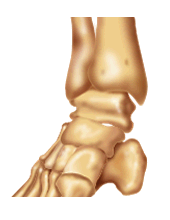The Ankle joint is a hinge joint formed between the bottom of the two bones of the lower leg-the small fibula on the outside and the large tibia on the inside - which together form a mortice - like structure which sits on top of the first bone of the foot, called the talus. The main movements allowed are flexion (pointing the toes down) and extension (pointing them up) together with a small amount of side-to-side movement (so that we can point the toes in or out). There are ligaments between the bones on both sides of the joint which help to stabilise it. These form part of the capsule of the joint which, like that of the elbow, is lax at the front and the back. The synovial membrane of the capsule secretes synovial fluid which lubricates the movement. A thin layer of cartilage lines the surface of the bones. The most powerful movement of the ankle - flexion, utilised every time we take a step - is brought about by the action of a muscle called the gastrocnemius muscle, better known to us as the muscle of the calf. This transmits its action through a tendon called the Achilles tendon which inserts into the back of the heel.
|

